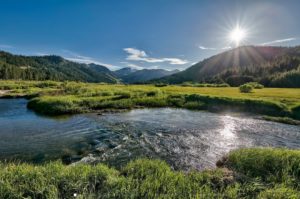Squaw Traffic – What Andy Didn’t Tell You
Recently Andy Wirth sent out a “midseason” update about Squaw (see link at bottom). Although he discussed the traffic problem and what Squaw is trying to do about it, he failed to mention what is going to happen to traffic and parking once the Village construction begins.
There is a section on parking within the Specific Plan and dEIR for the proposed Village at Squaw Valley that has important implications. It was not a highlighted area of discussion at either the Planning Commission nor the Board of Supervisors meetings because parking is not a CEQA topic (and therefore was not subject to review).
The parking analysis in the Plan noted that 3,100 parking spaces were all that were needed to support the current day skier population on all but the 4 busiest days. This number contrasts to the SVSH announced fact that more than 5,000 cars can and do squeeze into the parking lots and structures. The 3,100 number comes derives from a myriad of assumptions (Appendix G of the dEIR) about turnover in the parking lots, questionable skier counts, and peak demand being 75% of total daily demand.
As has been evident this season, it is obvious that even 5,000 car parking spaces are inadequate, let alone the 3,100. Over every reasonable weather window, the parking lots have been full by 9:30AM, and cars struggle to get out of the parking lot at 4PM. SVSH acknowledges the horrendous state of the available parking by advising people to come early, use carpools, or use public transport.
The height of difficulty occurred between Jan 29 and Feb 11 – although some other days were almost as bad. By numerous accounts, the backup to get into the parking lot extended at least a mile onto Interstate 80. The transit time from the interstate to the parking lot approached 2 ½ hours. By the time these unfortunate skier guests got to the Squaw Valley parking lots, they were, of course, full.
Some guests were lucky to find a car leaving but most guests parked illegally along Squaw Valley Road extending at least one mile from the ski lifts. Videos of this parking nightmare and of people walking along Squaw Valley Rd with their equipment have made the rounds of social media. For your amusement, here are a few.
Here is a picture of Squaw Valley Rd taken just east of Russell Rd. on February 11th…
And here is a movie on that same day travelling down Squaw Valley Road.
This video shows the people walking to the mountain and the SVSH shuttle bus driving right pass them. We are talking pretty close to a 1 mile hike!
On Saturday evening, a guest was hit by a car while walking back to their car in the dark. During the day, ambulances were slowed through the narrowed lanes. There was no hope of setting up the triple cones to alleviate the traffic of outbound skiers.
And what did SVSH or Placer County do about this. Nothing! There were no SVSH employees telling people that parking along Squaw Valley Road was illegal. There were no Sheriff nor CHP officers telling people not park there, nor were they ticketing.
The purpose of this note is not to ridicule the County employees nor SVSH, though criticism is probably justified. We wish to point out that 3,100 parking spaces is almost 2,000 less than what Squaw has now, and it is still not enough. Just imagine what the backups will be like when the day skier parking spaces are reduced by 40% due to proposed construction?
Moreover, the SVSH premise that there will be thousands of day skiers taking themselves off the road by buying condos in the proposed Village fails the logic test since there are available units today in the IntraWest Village and the horrible traffic and parking situation is not enough to drive those skiers into buyers. Why would that change in the future?
The SVSH Village proposal recommended the minimum amount of parking they can get away with as specified in the 1983 Squaw Valley General Plan – which was written 34 years ago and still governs what can and cannot be done with regard to development in Squaw Valley. Simply put, more parking means more expense for parking structures and/or fewer condos each of which decreases the developer’s rate of return.
Unfortunately the Final EIR provides no solution to this problem. Enticing day skiers into buses is a pipedream as long as they do not have a dedicated traffic lane (as in Aspen) which is not going to happen. Regrettably, the Board of Supervisors looks the other way and encourages even more development!
The fact is that the dEIR traffic analysis severely underestimates the current traffic situation on State Route 89 claiming average speeds of 46 mph and drive times of 13 minutes from Truckee to Squaw Valley during the busiest Saturday mornings of the year. That “alternate fact” flies in the face of the actual 1 to 2 ½ hours people spend on most weekend days.
And while SVSH recognizes the seriousness of this problem, their focus is on becoming a destination resort – the day skier is clearly playing second fiddle. Squaw has agreed to pay into transit and other funds, but nowhere near to the extent that will make a dent in the situation.
The only thing we, as day skiers, can hope for is that the situation, as bad as it is today, does not get demonstrably worse. The Village proposal needs to be downsized. For that to happen, the community needs to support the litigation that has been initiated by Sierra Watch. It was not the intent of the Friends of Olympic Valley for this litigation to happen. We had hoped all along for a “goldilocks” compromise, and even presented a plausible one to the Board of Supervisors that unfortunately fell on deaf ears.
One of the Sierra Watch’s arguments attacks the quality of Placer County’s state mandated environmental analyses and they point out, among numerous other deficiencies, that the County doesn’t accurately portray how bad traffic already is even though state law requires the analyses to compare impacts to baseline conditions.
Everyone knows that there is no quick and easy solution to the Tahoe traffic woes. But, as Isaac Silverman, Staff Attorney for Sierra Watch, pointed out in a recent post “when you are in a hole the first thing you should do is stop digging”!
Sierra Watch has taken action by suing over the adequacy of the environmental protections for this project. In the course of this action some more adequate mitigation or a smaller project could result. For those who favor this approach, donations to Sierra Watch can be made by clicking here:
Thank You.
Andy’s midseason letter….
Click hear to read Andy’s Letter


